Design of Radio Telescope System
Info: 5637 words (23 pages) Dissertation
Published: 11th Dec 2019
Tagged: EngineeringSciences
Software Specification
Our code was developed based on Data Acquisition Toolbox™ which provides functions for connecting MATLAB® to data acquisition hardware. The toolbox supports PC-compatible data acquisition hardware from multiple vendors, including Advantech, Measurement Computing, and National Instruments. The toolbox also supports Microsoft Windows® compatible sound cards. In addition, it is compatible with hardware from several data acquisition vendors via third-party adaptors With the toolbox helped in configuring data acquisition hardware and reading data into MATLAB® and Simulink® for immediate analysis, also sending out data over analog and digital output channels provided by data acquisition hardware. The toolbox’s data acquisition software includes functions for controlling analog input, analog output and counter/timer. The toolbox provides common base properties that apply to all supported hardware, such as sample rate, trigger settings, and channel properties. These properties promote code reuse and reduce the need to change code when changing hardware, also data is analyzed acquired or saved for post-processing. The legacy interface supports hardware from multiple vendors and all sound cards on 32-bit versions of MATLAB®, the legacy interface also supports voltage measurements of analog input, analog output, and digital I/O subsystems.Introduction
1.1 Overview
Since using optical telescope requires atmosphere that is not cloudy or rainy also cannot be used during daylight, we designed a telescope to detect the Meteors without any constraints depending on radio wave rather than the optical wave as used in optical telescope. The general principle of meteor observation in our design is illustrated in Figure 1.1 a radio receiver is located at a large distance from a transmitter at the same frequency. Direct radio contact is impossible due to the curvature of the Earth. When a meteor enters the atmosphere, its trail may reflect the radio waves from the transmitter to the receiver. At the receiver end, where the signal of the transmitter is normally not received, the transmission at the presence of the meteor trail can be received for a moment. The radio waves reflections can last from a tenth of a second to a few minutes. The received signal characteristics are related to physical parameters of the meteoric event.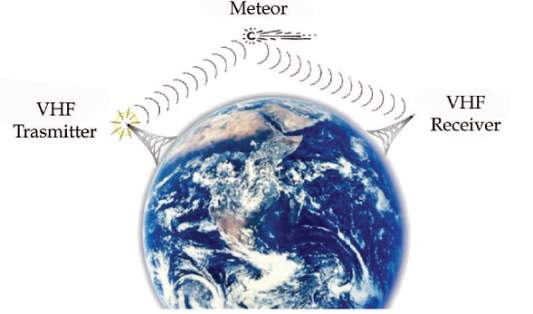 Figure 1. 1: Principle of Radio Telescope
Figure 1. 1: Principle of Radio Telescope
1.2 What is Radio Telescope
Radio telescope is an astronomical instrument consisting of a radio receiver and an antenna that is used to detect radio frequency radiation reflected by meteors .Because radio wavelengths are much longer than those of visible light, radio telescopes must be very large in order to attain the resolution of optical telescopes. Radio telescopes vary widely, but they all have two basic components a large radio antenna and radio receiver. The sensitivity of radio telescope depends on the area and efficiency of the antenna.1.3 Types of Radar
- Passive Radar: It’s a system that detects and track objects by processing reflections from non-cooperative sources of illumination in the environment, such as commercial broadcast and communications signals, for that there is no dedicated transmitter.
- Active radar: it’s a system that consist and control both a transmitter and receiver were usually located at the same site .It’s a technique of observing nearby objects by reflecting the transmitted signals off target objects and analyzing the echoes. This type can determine the distance to an object and the speed of the object too.
1.4 Radio Telescope vs. Optical Telescope
Radio telescope and optical telescope both examine electromagnetic radiation originating from outside the Earth's atmosphere. Where they differ is in the tools used to detect this radiation where in radio telescope its inexpensive compare to optical telescope its very expensive. And in the wavelength or frequency of the waves because radio waves are much longer than optical waves the radio telescopes must be much larger than optical telescopes. As we said before radio telescope can works in cloudy or rainy day also during daylight and telescope does not require the observer to be in monitoring site during all the observation period.1.5 What is the Meteor
Meteors or shooting stars are the streaks of light produced when a meteoroid burns up in the Earth's atmosphere. The meteoroids which produce the meteors are dust and rocks in space. If the meteor hits the ground, it is then called a meteorite and it will leave a hole in the ground.1.6 Electromagnetic spectrum
The electromagnetic spectrum is the range of all possible frequencies of electromagnetic radiation. Radio waves are a type of electromagnetic radiation with wavelengths in the electromagnetic spectrum longer than visible light as illustrated in figure 1.2. Have frequencies from 3 kHz to 300 GHz and the corresponding wavelengths are from 1 millimeter to 100 kilometers.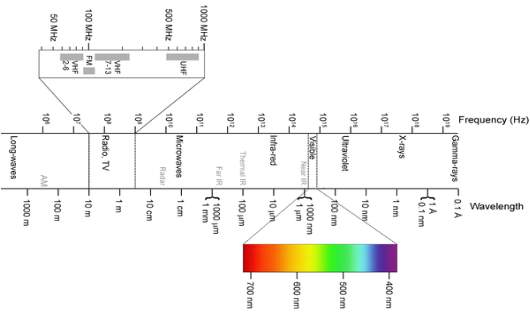 Figure 1. 2: Electromagnetic spectrum
The table below gives detailed information about the frequency range, the length of waves for each band and some typical uses of that portion of the radio spectrum.
Figure 1. 2: Electromagnetic spectrum
The table below gives detailed information about the frequency range, the length of waves for each band and some typical uses of that portion of the radio spectrum.
| Band | Frequency | Wavelength | Some Uses |
| VLF | 3 - 30 kHz | 100 km - 10 km | Long range navigation and marine radio |
| LF | 30 - 300 kHz | 10 km - 1 km | Aeronautical and marine navigation |
| MF | 300 kHz - 3 MHz | 1 km - 100 m | AM radio and radio telecommunication |
| HF | 3 - 30 MHz | 100 m - 10 m | Amateur radio bands, NRC time signal |
| VHF | 30 - 300 MHz | 10 m - 1 m | TV, FM, cordless phones, air traffic control |
| UHF | 300 MHz - 3 GHz | 1 m - 10 cm | UHF TV, satellite, air traffic radar, etc |
| SHF | 3 - 30 GHz | 10 cm - 1 cm | Mostly satellite TV and other satellites |
| EHF | 30 - 300 GHz | 1 cm - 1 mm | Remote sensing and other satellites |
1.7 Radio Waves Propagation
The radio signals interact with the objects and the media on its way, this interaction causes the radio signals to be reflected, refracted or diffracted which leads this signal to change direction and reach areas that it would be impossible to be reached if the radio waves travelled in a direct path. Most radio communication applications depend on the ionosphere region, since this region in the atmosphere enables radio communications signal to be reflected or more correctly refracted back to earth using sky wave. Sky Wave The radio signals leave the Earth's surface and travel towards the ionosphere where some of the signals are returned to Earth; these radio signals are called sky waves, in fact there are more than one layer inside the ionosphere that are responsible for the process of reflection.- Layer D
- Layer E
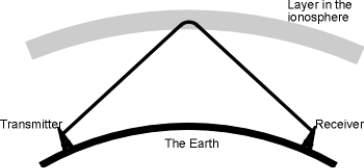 Figure 1. 3: Reflection in Layer E
Figure 1. 3: Reflection in Layer E
1.8 Trials
In our project we need a source of radiation to be available in most areas where the observation must be done and is easy to use:1.8.1 AM Signals
SinceAM signals travel by reflection from the ionosphere as shown in figure 1.4.It was inapplicable to use it because we cannot determine if the signals are reflected from objects or from the ionosphere as the original signals propagate. It was hard to use this type in our project so we moved to a different type.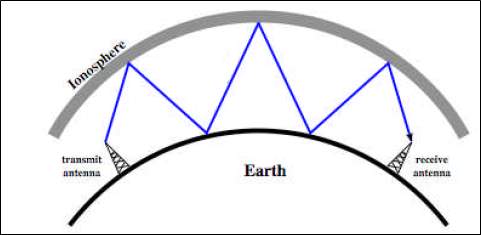 Figure 1. 4: AM signal propagation
Figure 1. 4: AM signal propagation
1.8.2 UHF signals
We started our attempts using TV tuning, since this type of receiver is available in old equipment in the university, but we have faced problems in obtaining the data sheet of this type of tuner and the equipment needed to operate on this frequency "UHF".1.8.3 FM signals
Because of the difficulties that we faced using AM and UHF frequencies we moved to FM radio frequency this type of radiation require line of sight between transmitter and receiver to propagate in the normal situation and now it available everywhere. Receiving radio wave from far away FM station is almost impossible due to the curvature of the Earth but when a meteor streaks through Earth’s atmosphere a part of its energy is released as light, the remainder is dispersed in a trail as ionized air, this electrified air will reflect the radio waves which are coming from commercial FM station. As a result, commercial radios are recommended to serve as a receiver. When tuning the radio to a FM radio station from the location of observation, music or voices can be heard if a meteor passes between the transmitter (the radio station) and the receiver.1.9 System structure and motivation
The aim of this project is to design a very simple system with the lowest expenses to detect the presence of meteors and connect to it a unidirectional antenna to cover only the area of observation where its propagation pattern is in one direction, then this antenna is connected to a FM radio receiver because the FM signals operate by line of sight and also the FM radio has better sound quality than AM radio.Radio Telescope Hardware
As explained previously, this project aims to detect meteors when it enters the atmosphere. The non-local FM radio signal will be reflected due to the occurrence of meteors. To achieve this objective our system must consist of two main parts:- Hardware
- Software
2.1 System Hardware
The easiest way to observe meteors by radio is to use commercial FM radio and connect it to a Yagi antenna as shown in Figure 2.1 then try to find an empty frequency from 88-108 MHz, where you do not hear any kind of music or voice and is being used by a distant transmitter mostly a distant FM radio station about 500-2000 km away from your location. After selecting the best FM Radio receiver; took the audio signal as an analog input to the sound card ”ADC” in the computer through the microphone port using 3.5mm Jack cable in order to convert it to digital signal. In addition, we need method to recording data and analyze it.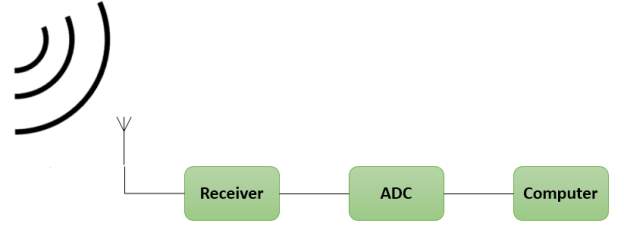 Figure 2. 1: Radio Telescope Hardware
Figure 2. 1: Radio Telescope Hardware
2.2 The Antenna
Antenna is an electromagnetic device that collects or emits radio waves. It consists of materials that conduct electricity arranged in such a way that it is in tune with the frequency of a radio signal, the antenna tuned to a particular frequency will resonate to a radio signal of the same frequency. When properly tuned an antenna will collect this energy and make it available to drive the amplifiers in a radio receiver. For the detection of meteors we constructed and attached an antenna to the receiver to collect the radio waves that cannot be heard by the human ear.2.2.1 Yagi Antenna
In our project we built a 3-element Yagi antenna, which is a useful form of RF antenna design and is widely used in applications where an RF antenna design is required to provide gain and directivity, as a result the optimum transmission and reception conditions can be obtained. It will efficiently collect the radiated energy of a distant FM radio station where its waves have been reflected by a meteor. The Yagi antenna as shown in figure 2.2 is one of the most popular and widely used antennas because of its simplicity, low cost, directional radiation and relatively high gain. The design has a dipole as the driven element, furthermore parasitic elements are added which pick up power from the dipole and re-radiate it in such a manner that affects the properties of the RF antenna as a whole. High gain is attained by the addition of parasitic elements positioned either in front or behind the driven element. These parasitic elements are called directors and reflectors depending on their lengths and positioning with respect to the driven element.2.2.2 Operation of the Yagi Antenna
The parasitic elements of the Yagi antenna operate by re-radiating their signals in a slightly different phase to that of the driven element. In this way the signals are reinforced in some directions and cancelled out in others. It is found that the amplitude and phase of the current that is induced in the parasitic elements is dependent upon their length, the spacing between them and the dipole or driven element.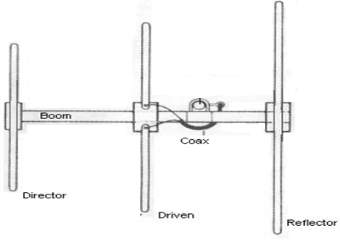 Figure 2. 2: The 3-Element Yagi Antenna
Using a parasitic element it is hard to have complete control over both the amplitude and phase of the currents in all the elements. This means that it is difficult to obtain complete cancellation in one direction. Nevertheless it is still possible to obtain a high degree of reinforcement in one direction with a high gain and a high degree of cancellation in the other direction to provide a good front to back ratio.
To obtain the required phase shift an element can be made either inductive or capacitive. If the parasitic element is made inductive it is found that the induced currents are in such a phase that they reflect the power away from the parasitic element, this causes the RF antenna to radiate more power away from it and this element is called a reflector. The parasitic element should be tuned below resonance by physically adding some inductance to the element in the form of a coil. Generally it is made about 5% longer than the driven element.
If the parasitic element is made capacitive it will be found that the induced currents are in such a phase that they direct the power radiated by the whole antenna in the direction of the parasitic element and this element is called a director. The parasitic element should be tuned above resonance by physically adding some capacitance to the element in the form of a capacitor or more commonly by making it about 5% shorter than the driven element.
Figure 2. 2: The 3-Element Yagi Antenna
Using a parasitic element it is hard to have complete control over both the amplitude and phase of the currents in all the elements. This means that it is difficult to obtain complete cancellation in one direction. Nevertheless it is still possible to obtain a high degree of reinforcement in one direction with a high gain and a high degree of cancellation in the other direction to provide a good front to back ratio.
To obtain the required phase shift an element can be made either inductive or capacitive. If the parasitic element is made inductive it is found that the induced currents are in such a phase that they reflect the power away from the parasitic element, this causes the RF antenna to radiate more power away from it and this element is called a reflector. The parasitic element should be tuned below resonance by physically adding some inductance to the element in the form of a coil. Generally it is made about 5% longer than the driven element.
If the parasitic element is made capacitive it will be found that the induced currents are in such a phase that they direct the power radiated by the whole antenna in the direction of the parasitic element and this element is called a director. The parasitic element should be tuned above resonance by physically adding some capacitance to the element in the form of a capacitor or more commonly by making it about 5% shorter than the driven element.
2.2.3 Yagi Antenna design
As we discussed earlier, this radio telescope will operate at a very high frequency band and specifically at FM radio frequency band, this band starts at 88 MHz and ends at 108 MHz, to make our antenna operates effectively at any frequency within this band we will choose the center frequency and designed the antenna based on it. set(AIVoice,'SampleRate',s); %Setting the sample rate for analog input object ActualRate = get(AIVoice,'SampleRate'); set(AIVoice,'Timeout',time); %Setting the timeout for analog input object set(AIVoice,'SamplesPerTrigger',ActualRate*duration );%setting specify number of samples to acquire for each trigger that occurs set(AIVoice,'TriggerChannel',chan); %setting the channel serving as trigger source set(AIVoice,'TriggerType','Software'); %setting the trigger type set(AIVoice,'TriggerCondition','Entering');%Indicate required condition before trigger event occurs set(AIVoice,'TriggerConditionValue',[NF 1]); %Specify voltage value that must be satisfied before trigger executes set(AIVoice,'TriggerRepeat',inf); %Specify number of additional times to execute trigger set(AIVoice,'TriggerDelayUnits','Samples') set(AIVoice,'TriggerDelay',-s*60) set(AIVoice,'BufferingMode','Auto'); %Specify how memory is allocated set(AIVoice,'LoggingMode','Disk&memory'); %Specify destination for logged data set(AIVoice,'LogFileName','Test.daq') set(AIVoice,'LogToDiskMode','Index'); %Specify whether data, events, and hardware information are saved to one or more disk files %Initial Trigger ao = analogoutput('winsound'); addchannel(ao,1); set(ao, 'SampleRate', 8000); t = linspace(0,2*pi,16000); y = sin(100000*t); putdata(ao, y'); set(ao, 'TriggerType', 'Immediate'); start(ao); %Finish start(AIVoice) %start analog device %wait until required time finished then plot z=get(AIVoice,'Timeout'); pause(z) returndata = ActualRate*duration*(AIVoice.TriggersExecuted);%get number of samples that executed [d,t] = getdata(AIVoice,returndata); %Extract analog input data, time, and event information from data acquisition engine plot(t,d) %plot data xlabel('Time (sec.)') ylabel('Signal Level (Volts)') title('Data of all Triggers') grid on stop(AIVoice) disp(' ') disp(' ') disp(' ') disp(' ') disp('*************************************************************') disp(' Result of Test ') disp('*************************************************************') disp(' ') disp(' ') %date and the time of start abstime = AIVoice.InitialTriggerTime; t = fix(abstime); x=sprintf('%d/%d/%d %d:%d:%d',t(3),t(2),t(1),t(4),t(5),t(6)); disp(['This test start at: ', num2str(x)]); disp(' ') NUMOFOBJ=AIVoice.TriggersExecuted-1;%-1 from initial triiger disp(['Number of unknown object that passed during this test : ', num2str(NUMOFOBJ)]); disp(' ') if NUMOFOBJ>0 disp('In these times.... ') showdaqevents(AIVoice) else end- Result Code
Cite This Work
To export a reference to this article please select a referencing stye below:
Related Services
View allRelated Content
All TagsContent relating to: "Sciences"
Sciences covers multiple areas of science, including Biology, Chemistry, Physics, and many other disciplines.
Related Articles
DMCA / Removal Request
If you are the original writer of this dissertation and no longer wish to have your work published on the UKDiss.com website then please:




